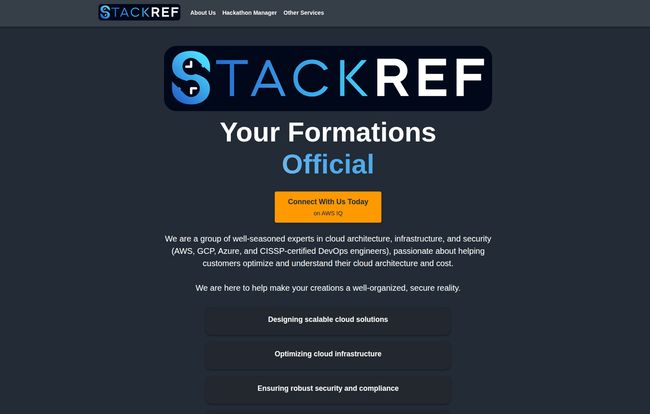I still have this vivid memory of a corporate hackathon from about five years ago. The excitement was electric, the free pizza was... well, it was free, and the ideas were flying. But behind the scenes? Chaos. Pure, unadulterated chaos. We spent the first four hours just trying to get our dev environments configured. One team almost took down a staging server. And the judging? Let's just say the project with the flashiest PowerPoint won, while a truly brilliant backend solution was completely overlooked. We all left exhausted, slightly demoralized, and wondering if it was worth the effort.
It's a story that's probably familiar to a lot of you in the tech space. We love the idea of hackathons—the innovation, the team bonding, the burst of creative energy. The execution, however, often feels like herding cats. In a hurricane. That’s why when I stumbled across a platform called StackRef, my curiosity was definitely piqued.
What Exactly is StackRef? More Than Just a Pretty Logo.
At first glance, you might think StackRef is just another cloud consulting firm. Their homepage talks a big game about being “a group of well-seasoned experts in cloud architecture, infrastructure, and security.” They name-drop the big three—AWS, GCP, Azure—and mention their team is full of CISSP-certified engineers. All good stuff, but pretty standard for a managed service provider.
But then you see the little gem tucked away in their description: their “own designed, self-hosted, soup-to-nuts, internal hackathon manager.”
And that’s where it gets interesting. StackRef isn't just a consultancy that could help you with a hackathon. They’ve built a dedicated platform to run the whole show for you. This isn't just project management software with a techy theme; it's a tool built by deep infrastructure experts to solve the very problems that drive engineers crazy during these events.
Ditching the Chaos: How StackRef Runs a Hackathon
So, how does it actually work? This is where StackRef seems to directly address the pain points I've felt in the past. It’s about creating a structured environment so creativity can flourish without being bogged down by logistics.

Visit StackRef
The Digital Arena: Unified Collaboration and Sandboxes
Remember my story about spending half the day on environment setup? StackRef tackles this head-on with team cloud sandbox environments. This is a brilliant move. It’s essentially a secure, isolated digital playground for each team. They can spin up resources, test wild ideas, and try to break things without any risk to your actual production infrastructure. For any CTO or Head of Security, that’s a massive sigh of relief. It provides guardrails, letting your developers run fast and free within a safe space. It’s the kind of feature that could only come from a team that lives and breathes cloud infrastructure.
Making it Fun: The Gamification Angle
Let's be real, a little friendly competition never hurt anyone. StackRef incorporates gamification to keep the energy and engagement high. Think leaderboards, progress tracking, and maybe even some digital badges. This isn't just fluff. During a 24 or 48-hour sprint, seeing your team climb the ranks can be a huge motivator. It turns the event from a pure coding slog into a more dynamic and interactive contest. It’s about tapping into that competitive developer spirit in a healthy way.
Enter the AI Judge: Objective Scoring is Here
This is the feature that really caught my eye. My biggest gripe with hackathons has always been the subjectivity of the judging. It often becomes a presentation contest, not a technical one. StackRef introduces AI-assisted scoring based on code quality.
Now, I know what you might be thinking. “AI judging my code? No thanks.” But the key word here is assisted. The goal isn't to replace human judges but to give them objective data to work with. The AI can analyze the code for things like efficiency, complexity, and adherence to best practices. This means that brilliant-but-boring-looking backend project I mentioned earlier? It would finally get the credit it deserves. It levels the playing field and ensures that solid engineering is rewarded, not just slick UIs. In my opinion, this could single-handedly change the dynamic of internal hackathons for the better.
Beyond the Hackathon: What Else is in the StackRef Toolbox?
The fact that StackRef also offers a full suite of cloud services adds a layer of credibility to their hackathon platform. These guys aren't just software developers; they're in the trenches managing complex cloud architectures every single day. Their services include:
- Designing Scalable Cloud Solutions: Building systems that can grow with a business.
- Optimizing Cloud Infrastructure: Helping companies manage their cloud spend and improve performance (a constant battle for many).
- Ensuring Robust Security and Compliance: This is huge. With CISSP-certified folks on staff, they clearly take security seriously.
- Providing 24/7 Support and Monitoring: The classic managed services offering that lets dev teams sleep at night.
This background knowledge is what makes their hackathon sandboxes and AI scoring so compelling. They're built from a place of deep, practical experience.
Let's Talk Brass Tacks: The Good, The Bad, and The Price Tag
Alright, no tool is perfect. After digging around, here's my honest take on StackRef.
On the plus side, the platform seems incredibly comprehensive. It’s a true “soup-to-nuts” solution that handles the most annoying parts of running a hackathon. The secure sandboxes are a killer feature, and the AI-assisted scoring is a potential game-changer for ensuring fairness. The fact that it's all backed by a team of certified cloud experts is a massive vote of confidence.
However, there are a couple of things to consider. Okay, so this is my one big pet peeve with a lot of B2B services, and StackRef is no exception: the pricing isn't public. You can't just go to their website and see a neat little table with pricing tiers. You have to “Connect With Us Today.” This usually means it’s a bespoke service tailored to the client, which makes sense, but it also means it’s probably not cheap. This isn't a $50/month SaaS tool you can just expense.
This leads me to believe that StackRef is probably best suited for larger organizations that are already investing significantly in their tech teams and see internal hackathons as a serious tool for innovation, not just a one-off pizza party.
Who is StackRef Really For?
So, who should be sending that contact email? In my view, StackRef is built for the Head of Engineering, CTO, or Innovation Lead at a medium-to-large company. It's for the leader who understands the value of developer time and wants to maximize the ROI of an internal innovation event. If you're tired of the logistical headaches, security risks, and subjective outcomes of your current hackathons, StackRef seems like a very compelling alternative.
If you're a small startup looking for a quick and dirty solution, this might be overkill. But for an established company that wants to professionalize its innovation process, this could be just the ticket.
Frequently Asked Questions about StackRef
Is StackRef just for big tech companies?
Not necessarily. While it seems geared towards larger organizations, any company with a sizable development team that runs internal hackathons could benefit. Think finance, healthcare, or any established industry looking to foster a more innovative tech culture.
How does the AI scoring actually work?
The site mentions it's based on "code quality." I'd interpret this to mean it uses static analysis tools and machine learning models to look at factors like code complexity, efficiency, potential bugs, and adherence to language-specific best practices. It's best viewed as a data point to help human judges make more informed, less biased decisions.
What cloud platforms do the sandboxes support?
Their homepage explicitly mentions expertise in AWS, GCP, and Azure. It's safe to assume their sandboxed environments can be provisioned on any of these major cloud providers, depending on what a company uses internally.
Why isn't there a public price list?
This is typical for enterprise-level services. Pricing likely depends on the number of participants, the duration of the hackathon, the complexity of the sandbox environments required, and the level of support needed. It's a bespoke service, not a one-size-fits-all product, so you need to contact them for a custom quote.
Can I use StackRef for public-facing hackathons?
The language on the site heavily emphasizes internal hackathons. While the technology could certainly be adapted for a public event, their primary focus seems to be on helping companies innovate from within. You would have to ask them directly if they support public events.
Is It Time to Rethink Your Hackathons?
At the end of the day, a hackathon is an investment. A significant one. You're pulling dozens of your most expensive, talented people off their regular projects for a couple of days. Doesn't it make sense to put a structure in place that ensures their time is used effectively and the results are judged fairly?
StackRef presents a compelling argument for doing just that. By taking the logistical nightmares and security worries off the table, it allows developers to do what they do best: build cool stuff. While the lack of transparent pricing means you'll have to make that first contact, for any organization serious about fostering genuine innovation, it seems like a conversation worth having. It might just be the cure for the common hackathon.
Reference and Sources
- StackRef Official Website
- Forbes: The Staying Power Of The Hackathon (And How To Run One Successfully)



